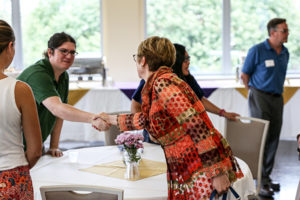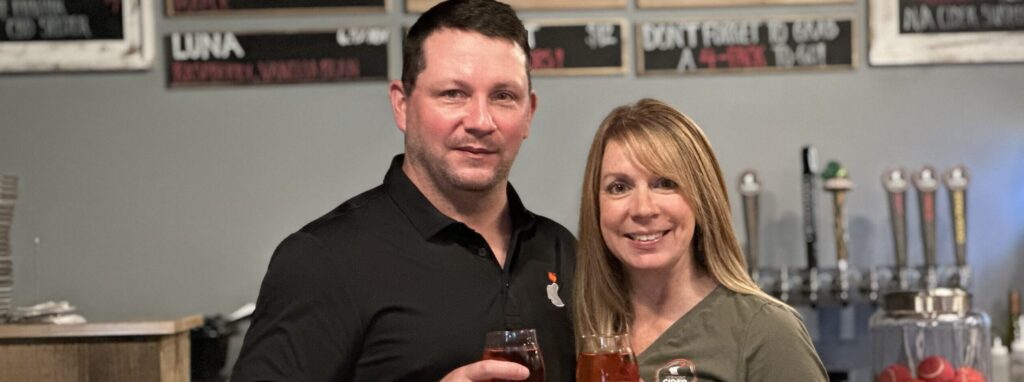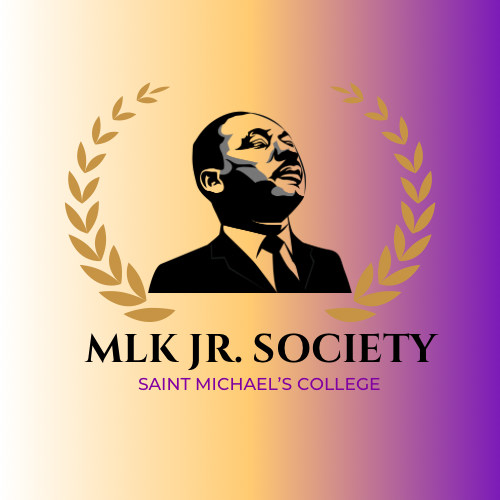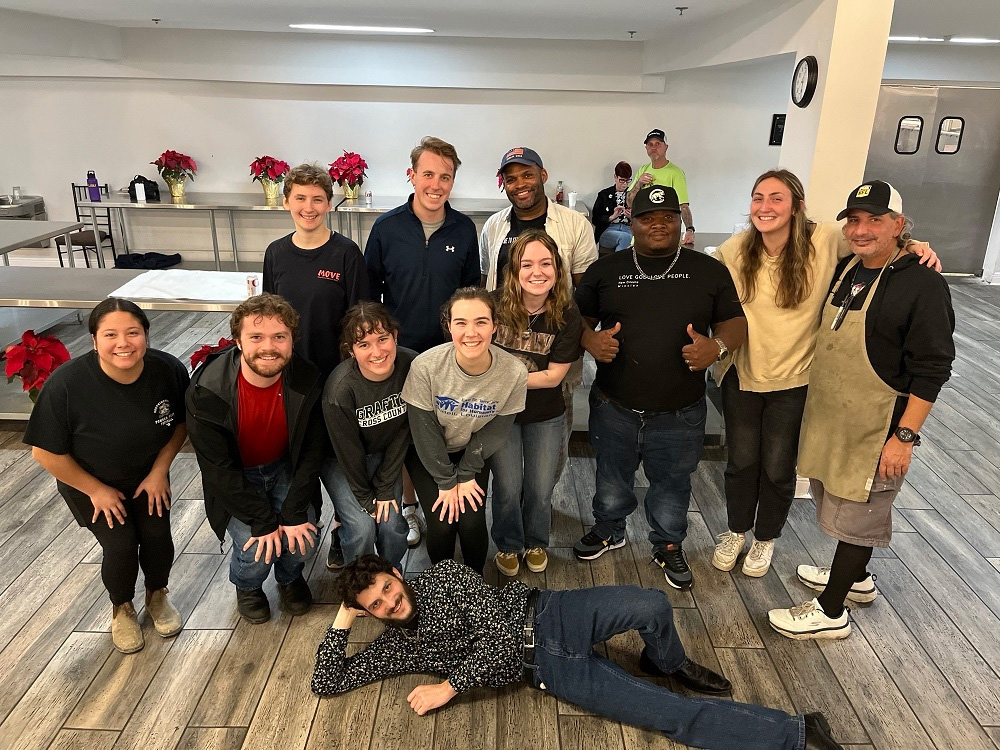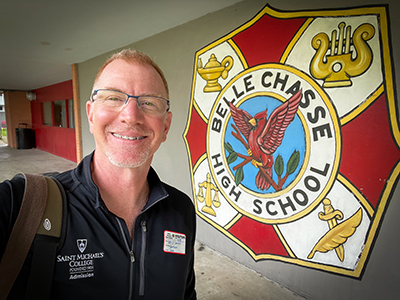Final summer research luncheon about transitions

The header photo shows student Lauren Stone telling about her summer writing project; directly above, Interim VPAA and Dean Jeff Trumbower offers his approval of Saint Michael’s summer research as the event begins; other photos show Sam Vaal, a group working with Professor Ruth Fabian-Fine on neurotransmitters, Conor Macias, Talia Lawrence, Chase Plante, and at bottom, President Sterritt greeting and hearing from economics student-researcher Zachary Pierce at lunch with Dean Trumbower. (photos by Ethan Simmons)
“Transitions” felt like a theme during the final summer luncheon for student undergraduate researchers at Saint Michael’s College on Tuesday, July 24 in the Dion Family Student Center Roy Room, sponsored by the Academic Affairs office.
Certainly the student reports about their eight weeks of focused mentored independent projects exploring a wide variety of topics across academic disciplines marked a transition to the next phases of their emerging professional lives and yet more advanced studies.
Beyond that, in the audience was a new president of Saint Michael’s College since the last research lunch in June – President Lorraine Sterritt, whose term began July 1. As her predecessor Jack Neuhauser was known to do at these research events (which he helped to expand as a priority during his tenure), President Sterritt offered words of encouragement and appreciation for students’ impressive achievements.
The event also had a new master of ceremonies — Jeffrey Trumbower, dean of the College, who recently also assumed interim duties as vice president for academic affairs after the former VPAA Karen Talentino ended her term to return to teaching as of July 1.
At the very start, Trumbower said of Talentino (present in the audience at a table with students), “I want to take a special moment to really thank someone who has been the spearhead behind student research here at Saint Michael’s … It’s really been her and her vision that helped shape some of the program, that helped shape these lunches, and she has put a high priority at the college on student summer research and research all during the year, so I think we owe a tremendous debt to Karen for that.” Extended applause greeted his remarks.
Student biology summer researcher Emily Ferreri (Hyde Park, NY), student representative on the presidential search committee, introduced President Sterritt, who, in her brief remarks of welcome, recounted las t week visiting Ferreri and Mitch McDonald (Prior Lake, MN) in their Cheray Science Hall lab where they’re looking at the DNA of wildcats, increasing her knowledge on that topic “exponentially”– she joked that she was glad such knowledge was not part of the presidential search since she would have failed the test.
t week visiting Ferreri and Mitch McDonald (Prior Lake, MN) in their Cheray Science Hall lab where they’re looking at the DNA of wildcats, increasing her knowledge on that topic “exponentially”– she joked that she was glad such knowledge was not part of the presidential search since she would have failed the test.
After a fine buffet meal of chicken cacciatore and sides, Trumbower invited students to come to the podium for short summaries of their research experiences: what went right or wrong, where they had to change something or had a hypothesis affirmed, what conclusions they might have reached, what they learned.
Sam Vaal, senior chemistry major (Manchester, NH/mentor Shane Lamos), started the reports, explaining that in looking at effects of acid mine drainage and pollution at aba ndoned copper mines, he has found high amounts of aluminum, copper and iron “almost everywhere on the site,” with concentrations of those metals moving downstream to dams which, besides stopping floods, also seem to stop pollution. “Now we’d like to study how it’s stopping that pollution further in the fall,” he said.
ndoned copper mines, he has found high amounts of aluminum, copper and iron “almost everywhere on the site,” with concentrations of those metals moving downstream to dams which, besides stopping floods, also seem to stop pollution. “Now we’d like to study how it’s stopping that pollution further in the fall,” he said.
Joseph Brach (Melrose, MA/pre-pharmacy/mentor Shane Lamos of chemistry) told of doing similar types of testing on and nearby the Saint Michael’s campus sites to see if anything is contaminated, using the same equipment that Vaal uses, “and so far all the samples that we have collected and analyzed, they’re all below EPA standards [for contamination], so we’re good with that – we’re all safe for now!”
Next up was the large group (eight students)  working together under Biology Professor Ruth Fabian-Fine to study different aspects of neurotransmitters by using Central American spiders. One after another, they described their procedures and findings in impressive scientific detail, “The next step will be to write and publish our findings,” reported one of the students.
working together under Biology Professor Ruth Fabian-Fine to study different aspects of neurotransmitters by using Central American spiders. One after another, they described their procedures and findings in impressive scientific detail, “The next step will be to write and publish our findings,” reported one of the students.
Alyssa Valentyn (Medford, MA) said her biology work with Professor Declan McCabe involving trail cameras was focusing on species composition across campus lands beyond “The View” (as the area across Route 15 is popularly known), to see what diversity among species there reveals on whether the area is actually a wetland or not a wetland. They are still waiting for some results before reaching a firmer conclusion on the matter, she said.
Nick Sette (environmental science, mentored by Scott Lewins of biology faculty and Kristyn Achilich ’05 who directs the Campus Farm), has been studying two invasive insects on that farm. So far he’s identified leek moth damage on uncovered onions but none on covered onions; next they’ll harvest onions in early August to see of moth damage affected yield, along with looking at kale.
Ethan Brookner (Minneapolis, MN/McCabe/Environmental Science) reported that his work with the trapping cameras in the Wilderness area across Route 15 is about to become more interesting since “we just took all or our cameras back into the lab yesterday [to] go through photos and analyze our results. We should know what we’re going to do with our hypotheses by the end of the week, which is exciting.” He said the trail cameras have given his group “some really interesting photos and some not interesting photos,” with a real highlight being some photos of bobcats.
Mitch McDonald (Prior Lake, MN/biology/Loisel) described his work among the group with Professor Loisel characterizing genetic diversity in the U.S. bobcat population and comparing Vermont’s bobcat population to the rest of the nation. His particular work has focused on something called the HGH gene, an antiviral gene that targets immune-deficiency virus in the felines. “We were able to describe the genotypes of 65 Vermont bobcats, 43 California bobcats and 34 Florida bobcats,” he said. They discovered that the genotypes of individuals infected did not seem to correlate to their infections. The group also sequenced the HGH gene in six Canadian lynx and found it to be unique. “It tells us how wild species differ genetically and how they combat viral pathogens,” he explained.
Emily Ferreri told of her role in some of those same studies, and shared how “there’s practically no differences between the Vermont bobcats and the Florida bobcats.” Other presenters also told of aspects of the bobcat work with Loisel.
Projects Beyond Science
Economics major Zach Pierce (Burlington, VT, mentored by Professor Patrick Walsh), said in his inquiry about whether special compensation affects re-enlistment rates in U.S. Armed Forces, that he found that “during times of higher conflicts, increased pay actually has less of an effect than it would during times of peace,” explaining, “during times of conflict, especially when there’s low public support and high conflict, that extra pay becomes less effective at retaining soldiers.” He is still waiting to hear about a Freedom of Information Act request to get more relevant government data to back his findings.
Secondary education/history major Abigail Adams (Granville, NY, Bedell/Wigglesworth faculty mentors), said she went into her project “trying to make sense of modern education” and its current controversies, which was “a wonderful challenge.” She discovered “how complex, political but also rewarding the field of education is.” Her goal was to find the best way to teach social studies to make content relevant to students. She interviewed 18 teachers and surveyed 10 students. Many respondents saw a key goal of social studies as helping people to have difficult and controversial conversations, and to be critical thinkers who see multiple perspectives. For her final product she will present her findings to curriculum groups and university classes as well as colleagues during student teaching. “Before this project I only had a theory about what it means to be a social studies teacher but now I have practical knowledge,” she said — though having more questions now than when she stated eight weeks ago – which is “how I know I will make it.”
Conor Macias (music/psychology double-major, New Rochelle, NY)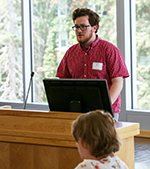 said his goal of composing musical pieces that reflect mental disorders is going along well since he first reported at the June lunch. He’s been listening to many composers, doing research on what it’s like to live with disorders like OCD, bipolar disorder and schizophrenia, and has been “trying to create a mental sound picture.” He hopes to assemble a seven-piece ensemble to perform his work for a senior recital this coming year.
said his goal of composing musical pieces that reflect mental disorders is going along well since he first reported at the June lunch. He’s been listening to many composers, doing research on what it’s like to live with disorders like OCD, bipolar disorder and schizophrenia, and has been “trying to create a mental sound picture.” He hopes to assemble a seven-piece ensemble to perform his work for a senior recital this coming year.
Sara Rodgers (Cheshire, CT/Environmental Studies/Achilich mentor) said her study of campus food security has led to ideas and feedback about how best to possibly administer students’ theories on this topic in some practical way on the Saint Michael’s campus, based on her one-on-one interviews with several students.
Conor Dunne (biology, Nazareth, PA) described his investigation of zebra mussels in Lake Champlain and their effect on some other lake invertebrates. “There’s still a lot of data that needs to be collected,” but his results so far contrast with his hypothesis — that the mussels would help certain species by their shells offering protection from predators. That doesn’t seem to the case, his data show. Melanie George, working on some of the same issues, is in the process of measuring the abundance and survival of native mussels, and it seems that as zebra mussels increase, “there are less live native and more dead ones,” she said. Spencer Roberge (McCabe/biology/Bristol, CT), has found in his research that the Missisquoi River and St. Albans Bay are more rich in species than the inland sea, which seems to correlate to zebra mussels.
MaKayla Foster (English/elementary education double-major/Christina Root mentor) has been writing her own memoir of growing up on a Vermont dairy farm, the loss of her father, and other experiences. Her work is guided by transcendentalists, romantics and other contemporary memoir authors. “I discovered how nature offers a temporary escape from obligations and a welcome sense of solitude,” she said.
Another student doing a writing project was Talia “Izzy” Lawrence (Newark, NJ/English/Education/Root). 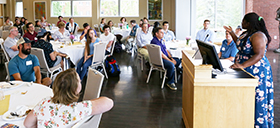 She originally planned to write short stories reflecting aspects of life for African American women, but decided after encountering some frustrations in that approach to write more of a memoir of her own experiences as an African American woman. “I believe writing this style got a little bit therapeutic for all of my angry rants about what’s been going on in my life and how people are interacting with me as a black woman.” Lawrence said.
She originally planned to write short stories reflecting aspects of life for African American women, but decided after encountering some frustrations in that approach to write more of a memoir of her own experiences as an African American woman. “I believe writing this style got a little bit therapeutic for all of my angry rants about what’s been going on in my life and how people are interacting with me as a black woman.” Lawrence said.
The next writer to talk was Lauren Stone (New Lebanon, NY/sociology/mentor Liz Inness-Brown) – shown in the large photo above the headline, with her service dog. She said, “This summer I especially learned the power of simplicity in my writing,” which has transformed the way she approaches revision. She also has “learned the importance of creating a consistent and believable universe for my characters,” and, “I feel like I have begun to grasp the art of building complex literary realities with this new skill, and I hope to show my readers the thrill of being immersed in a life that is not their own.”
Ellie Moore (Marlborough, CT/English/Environmental Studies/Will Marquess mentor) described her work to possibly start an environmental literary publication on campus. She’s developed a mission statement for such a journal, and she presented that in the form of a well-received poem that ended with the line, “Most of it possibly useless, but beautiful still, and necessary.”
Chase Plante (Center Barnstead, NH/sociology/international relations/Peter Vantine mentor) has learned a lot about the press and its power over politics, by studying French revolutions in history (he has a French minor). “It seems like the press is very, very good at catalyzing the disruption of the state…by increasing polarization,” he said, while propaganda then can be useful for putting states back together, post-revolutions.
by studying French revolutions in history (he has a French minor). “It seems like the press is very, very good at catalyzing the disruption of the state…by increasing polarization,” he said, while propaganda then can be useful for putting states back together, post-revolutions.
Erin Williams (biochemistry/Greenville, MI/Christina Chant mentor), told about studying protein-folding and how a highlight was obtaining some plasma for free from a generous professor in France — “and I transformed and expressed it,” and will continue the work in the fall. “I’m looking forward to purifying this protein, then moving on to study it…” she said.
Kara Hettinger (Lindenhurst, IL/environmental science/political science), has been studying the pH in soils of the Campus Farm. “The hope is that with this new information the farm staff will be able to better analyze how and if they should amend the soil,” she said.
Meghan Meyers (Colchester, VT, chemistry, Chant), described work analyzing maple syrup, finding “there was no added sugar!” and she’s applying for a grant to the North American Maple Syrup Council. “I hope to be able to continue my research and study … through the syrup production season,” she said.
Meghan Feenan (Groton, MA/elementary ed/Jonathan Silverman mentor), was looking at how elementary students are gaining knowledge in environmental conservation. She identified five aspects of quality conservation education: awareness of sustainability, ability for students to ID and be aware of species in their environment; awareness of food production, art and artistic representation, and personal connection to nature and the environment as a whole.
Samantha Delaney (Smithtown, NY/biochem/Chant) was another student-scientist, working “to express and purify a DNA binding protein” as part of a larger effort to control the transcriptional levels of certain genes within cells. She looks forward to repeating the process with another protein sample, she said.
Amanda Spink (Gorham, ME/chemistry/Heroux) described her work with catalysts to speed up the production of biodiesel fuel. The work made use of infrared spectroscopy, a useful skill at which to become adept.
In wrapping up, Trumbower said he would be looking into better ways for students to share their work online so others can look at it more closely. He reminded students that they owe a brief report of their work to his office by October 1, and that they might be asked to speak about the experience to various groups in the coming year while sharing work during the spring Academic Symposium.
Said President Sterritt after the presentations, “I was really delighted to be here, and I’m especially impressed to see the range of topics that our students were working on, and the in-depth work that they were doing, whether it was English literature or chemistry, they really had a handle on some really important questions. So it was very impressive.”